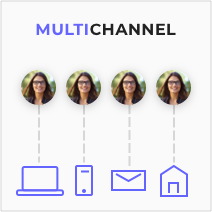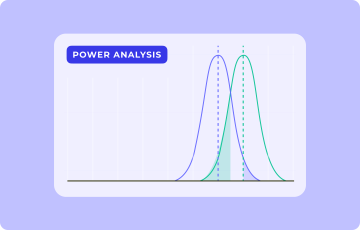
Creating a winning omnichannel strategy with personalization
The majority of your customers now use multiple channels on their journey before finally converting. This means that to meet the ever-rising expectations of these omnichannel consumers and guarantee the same quality of experience on every channel, you must rethink your entire strategy. Embracing the latest AI-driven personalization technologies and constantly A/B testing give you the ability to deliver this omnichannel experience.
1 Unique customer journeys
a growing number of tools and touchpoints
With a growing number of tools and touchpoints, customer journeys are increasingly complex and individual. Previously the only way for customers to make contact with your brand was by visiting a store or contacting customer service. Now by contrast there is a huge range of available channels that they can use to interact and convert with your brand:
- Online channels: websites on all devices (desktop, mobile, tablet), social media, display advertising, apps on mobile and tablet, email.
- Offline channels: stores, call centers, physical advertising.
new consumption habits and diverse journeys
This multiplication of channels has led to new consumption habits and diverse journeys that vary hugely between customers:

This means there are now many more possibilities for contact - you must be able to successfully reach your customers at all times and on all available channels.
As these figures show, consumers expect brands to adapt to their journey:
- 85% of consumers start their purchasing journey on one device and finish it on another
- 87% of consumers research online before going into a store - 79% do so while actually in-store
- 35% carry out research after having been to a store (via a search engine or the brand’s app/website)
- 75% of consumers expect brands to be capable of offering a continuous experience when moving between channels so they don’t have to start over each time.
Brands must therefore rethink their marketing strategies so that they can offer a personalized experience that takes into account the fact that customer journeys are no longer as linear as in the past.
2 Multichannel, Cross-channel and Omnichannel - what are the differences?
New innovation and technologies have seen marketing practices evolve to attempt to successfully unify the customer journey across the different touchpoints and media used by consumers. A few years ago the trend was for multichannel, then it shifted towards cross-channel before eventually embracing an entirely unified journey with omnichannel.
What is multichannel?
Multichannel is when a brand has different channels available for users to interact with it - for example, stores and a website. However, these touch points are not necessarily connected, highlighting the issues for the experience. This led to a need to evolve towards cross-channel strategies. Illustration “what is multi-channel”

What is cross-channel?
Cross-channel is when all channels offered by a brand are interconnected to make the visitor experience as seamless as possible. For example, a website that gives consumers the option to pick up an item in-store is offering a cross-channel experience.

What is omnichannel?
An omnichannel strategy connects all different channels with an entirely unified experience. A visitor must be able to enjoy a continuous and personalized experience while moving between touchpoints and devices. For example, a website that allows visitors to check the stock level of a particular product in-store is part of an omnichannel experience.

Omnichannel is the most evolved version of these three approaches to unify the visitor experience.
Additionally, all research shows that this approach enables brands to improve visitor engagement, conversions and loyalty.
- On average, the customer lifetime value (LTV) of omnichannel consumers is 30% higher than that of consumers using only one channel.
- Omnichannel consumers spend around 4% more than other consumers each time they buy in-store and 10% more when buying online.
- Omnichannel consumers are more loyal. After six months of experience with a brand, they went in-store 23% more often on average. They are more likely to recommend the brand to friends and family compared to those who use only one channel.
- Companies with an omnichannel strategy retain an average of 89% of visitors, compared with 33% for brands that don’t use an omnichannel approach.
To increase your conversion rate and build a strong, individual relationship with each visitor, brands must put in place an omnichannel strategy and personalize the visitor experience.
3 4 levers to implement a solid omnichannel strategy
As the figures show omnichannel should be the goal that all brands are working to achieve. So, what are the levers brands need to activate to put in place an omnichannel strategy?
We have identified four:
- Matching data across all channels
- Optimizing touchpoints and understanding visitor expectations
- Removing internal organizational silos
- Identifying actionable personalization use cases
1. MATCHING DATA ACROSS ALL CHANNELS
The main challenge in omnichannel is bringing together all the data collected across different channels to create a unique view of a visitor’s progress down the conversion funnel. This may seem obvious, but 92% of businesses still find it difficult to access, unify or analyze their data, which prevents them from using it properly.
To match the data relating to an individual visitor, they have to be identifiable (for example, signed in to your website), and this has to be the case on every one of the channels and devices they are using. That is why it is highly recommended to provide multiple prompts encouraging visitors to create an account as soon as possible and to encourage them to log in as soon as they return to your website.
A personalization solution designed for omnichannel
To be able to match visitor data coming from different channels and act on it in real-time regardless of channel, brands need a personalization solution designed for omnichannel. With this, you can automatically retrace the visitor’s omnichannel journey on all devices used, starting at the point where they signed in at least once on their device.
This enables you to provide the same personalizations to a signed-in visitor who is browsing on your website and then visits you later on their tablet via your app. For a 360-degree personalization approach, and if the visitor is not signed in, you also need to be able to unify their journey across other communication channels, for instance by showing a visitor who has been shown a personalization on your website the same message as part of a successful retargeting or display campaign (via Google Ads or Facebook for example).
Additionally, even if you’re unable to identify the visitor by name, you can personalize their journey according to the context of their visit, such as by looking at how they arrived on your site. So, if you can see that a visitor has come to your website via an ad on social media, you can then show them the same ad when they land on your homepage.
2. OPTIMIZING TOUCHPOINTS AND UNDERSTANDING VISITOR EXPECTATIONS
The goal of an omnichannel strategy is to facilitate switching from one channel to another so that visitors can easily and quickly move to the channel that best suits them. The key to success here is being able to identify a visitor’s preference for one channel over another, so as to encourage them to use the right one, i.e. the one on which they will convert.
Calculating the conversion probability of a visitor on a channel
With Kameleoon’s AI-driven personalization solution, you can calculate each visitor’s preference for one channel over another in real-time. You can then guide the visitor towards their preferred channel as identified by the algorithm.
The Kameleoon platform natively captures all visitor data i.e. the intent data which indicates the interests and conversion propensity and probability of your visitors. This intent data includes their browsing journey, product categories viewed, scrolling, time, date and geolocation. In short, it includes all information linked to their current visit. You can also onboard your entire data ecosystem onto the platform, such as the data coming from your CRM, DMP and data lake. The platform’s AI-driven engine then processes all this information, establishes correlations between visitors and predicts the conversion probability of each visitor for a given action in real-time. In this particular case, we configure the algorithm so that the conversion probability is calculated for each channel.
Here are examples of actions that you can put in place to guide your visitors towards another channel as soon as you’ve identified their preference:
- Facilitating access to your brick-and-mortar stores
In retail, customers have two possibilities: buying online or in brick-and-mortar stores. Although e-commerce is now widely adopted, some consumers may still prefer to buy in-store. Thanks to predictive algorithms, you can identify the conversion probability of a visitor on a given channel.
If one of your visitors seems more interested in buying in-store, you can put in place actions that enable them to easily move to this channel. For example, you can change the order of your CTAs so that the “Collect in-store” or “Check availability in-store” button is more visible on your product information page. You can also push a pop-in to the visitor as they browse on the website, asking them to enter the location of their favorite store, so that only products available in that store are displayed
- Facilitating access to telephone customer service
In the travel sector, purchases are often an expensive, large-scale commitment. This means that consumers often need time to consider them, making online conversion more difficult. This means that many visitors still research online, then go through to a contact center to finalize their purchase. A predictive personalization platform enables you to identify which visitors are more likely to convert following telephone contact with customer service, and then provide them with a personalized pop-in with a summary of their searches and offering a call-back to finalize their booking.
- Facilitating access to your app
Consumers have their habits and some prefer to buy on your website while others will prefer your app. You can identify those visitors who are more likely to convert on your app, and then launch pop-in suggesting that they download your app for easier browsing, adapted to their device.
3. REMOVING INTERNAL ORGANIZATIONAL SILOS
The most commonly observed barrier to successful omnichannel adoption is that different departments (such as marketing, CRM, IT) operate in silos. If the different teams don’t communicate, implementing an omnichannel strategy will be difficult, since it requires close internal coordination. Increasingly, however, companies are becoming aware of this need. “Head of omnichannel” roles or even teams dedicated to customer experience personalization are being created, to orchestrate the move to a unified customer journey approach across all the departments in a company. A team dedicated to Conversion Rate Optimization (CRO) can also play this role in your company.
4. IDENTIFYING ACTIONABLE PERSONALIZATION USE CASES
This is an essential part of personalization - if you want your strategy to deliver the expected results, you must first study the behavior of your customers and prospects.
What do they do when they interact with you? What content do they consume and how? You must identify measurable use cases with significant ROI.
Take one of the experiments run by retailer Auchan.fr with the aim of aligning experiences across all channels. In the Auchan sales and marketing actions calendar, a week of in-store promotions in the Baby section was scheduled. The team decided to combine this offline program with relevant online activity.
Offline, the retailer could only target those visitors interested in the Baby section when they are actually physically in-store. With online media, it’s possible to have more information on visitors’ interests. Auchan:
- Captured visitors’ intent data on the Auchan.fr and Auchan Drive websites
- Matched this with offline data for signed-in visitors (via their loyalty scheme) existing in the DMP
The brand used this to successfully identify which online visitors were showing a strong interest in the Baby section. Once identified, these visitors were shown a relevant promotional offer on all channels:
- A banner on the homepage of the Auchan.fr website
- A banner on the Auchandrive.fr website
- An email
- A push notification on the app
- An ad on Facebook.

'This omnichannel operation showed us how complementary our different channels are, since a significant proportion of visitors showing interest in baby products would only have been reached through a single channel if the data had not been matched. The next step will be to industrialize the production of content for all sections to leverage the results we’ve obtained.'
Émeline Démineur, Web Analyst & Conversion Manager, Auchan Retail.

You must consider your personalization strategy holistically. The customer experience you offer has to be unique and tailored to the customer, regardless of the device they are on or the touchpoint they are using to interact with your brand. An AI-based predictive personalization solution is essential to creating and delivering a winning omnichannel strategy, since it enables you to activate the four levers needed to be successful: matching your data, optimizing your touchpoints, removing organizational silos and identifying actionable use cases.




